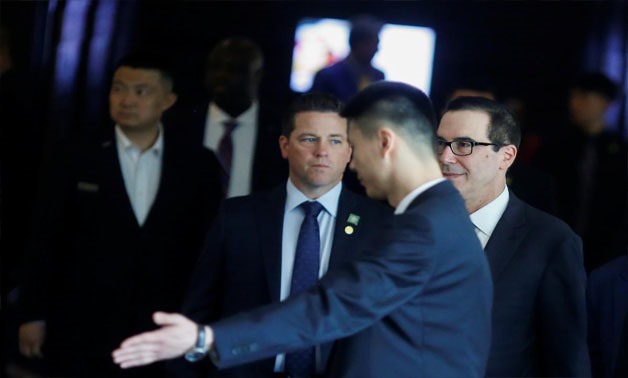
U.S. Treasury Secretary and member of a U.S. trade delegation Steven Mnuchin leaves a hotel in Beijing, China, May 4, 2018. REUTERS/Thomas Peter
WASHINGTON/BEIJING - 5 May 2018: The Trump administration has drawn a hard line in trade talks with China, demanding a $200 billion cut in the Chinese trade surplus with the United States, sharply lower tariffs and advanced technology subsidies, people familiar with the talks said on Friday.
The lengthy list of demands was presented to Beijing before the start of talks Thursday and Friday between top-level Trump administration officials and their Chinese counterparts to try to avert a damaging trade war between the world’s two largest economies.
A White House statement did not mention specific demands, but said the U.S. delegation “held frank discussions with Chinese officials on rebalancing the United States–China bilateral economic relationship, improving China’s protection of intellectual property, and identifying policies that unfairly enforce technology transfers.”
The statement gave no indication that U.S. President Donald Trump would back off on his threat to impose tariffs on up to $150 billion in Chinese goods over allegations of intellectual property theft.
The delegation was returning to Washington to brief Trump and “seek his decision on next steps,” the White House said, adding that the administration had “consensus” for “immediate attention” to change the U.S-China trade and investment relationship.
Trump said he would meet with the delegation on Saturday. “We will be meeting tomorrow to determine the results, but it is hard for China in that they have become very spoiled with U.S. trade wins!” he said in a Twitter post late on Friday.
China’s state-run Xinhua news agency described the talks as “constructive, candid and efficient” but with disagreements that remain “relatively big.”
Tariff threats have roiled stock markets in recent weeks, but the inconclusive outcome of the Beijing talks did little to stop a rally in U.S. shares prompted by jobs data that eased fears of faster Federal Reserve rate hikes. Stocks in Shanghai ended 0.5 percent lower while they fell 1.3 percent in Hong Kong.
Trump told reporters in Washington that he was determined to bring fairness to U.S.-China trade.
“We will be doing something one way or the other with respect to what’s happening in China,” Trump said. He added that he had “great respect” for China’s President Xi Jinping. “That’s why we’re being so nice, because we have a great relationship.”
China during the meetings asked that the United States ease crushing sanctions on Chinese telecom equipment maker ZTE Corp, people with knowledge of the matter said.
Washington’s demand for a $200 billion cut from China’s U.S. goods trade surplus doubles Trump’s previous request for a $100 billion cut. China had a record U.S. goods trade surplus of $375 billion in 2017.
Trump has also demanded “reciprocity” between U.S. and Chinese tariffs, frequently complaining about China’s 25 percent car tariff while the U.S. equivalent is 2.5 percent.
The U.S. team, led by U.S. Treasury Secretary Steven Mnuchin, demanded that China lower tariffs to levels no higher than those imposed by the United States, two people familiar with the demands said. The delegation also asked China to halt subsidies for advanced technology linked to its “Made in China 2025,” the sources said.
At the heart of the dispute are U.S. allegations that Chinese joint venture requirements and other policies force American companies to turn over their intellectual property, costing them billions of dollars annually and giving China’s state enterprises an edge in the race to develop new industries crucial to future growth.
China denies such coercion. Its 2025 industrial plan seeks to upgrade China’s manufacturing sector to more advanced products, including information technology, semiconductors and aircraft.
“I think the U.S. is asking for the impossible. Reducing the deficit by $200 billion by 2020 is quite an unrealistic demand, but it may also be a negotiation tactic to start high first,” said Tommy Xie, economist at OCBC Bank in Singapore.
BEIJING OFFERS
China offered to increase U.S. imports and lower tariffs on some goods, including cars, according to the sources. But Beijing asked the United States to treat Chinese investment equally under national security reviews, refrain from new restrictions on investments and halt a proposal to impose 25 percent tariffs under its “Section 301” intellectual property probe.
China also offered to reconsider anti-dumping duties on U.S. sorghum, according to a proposal it submitted.
Xinhua said there had been exchanges of opinion on intellectual property protections, expanding U.S. exports and bilateral services trade. It gave no indication of what actions might be taken but said the two sides committed to resolve their trade disputes through dialogue.
U.S. negotiators agreed to bring up the ZTE sanctions with Trump after new representations from the Chinese side, Xinhua said. ZTE was hit last month with a seven-year ban on American companies’ selling components and software to it after the U.S. Commerce Department found ZTE failed to comply with an agreement to settle breached U.S. sanctions on Iran.
“My impression was that (the talks) didn’t go well given the rhetoric,” said Kevin Lai, senior economist at Daiwa Capital markets in Hong Kong. “I think the divide is still very big.”
In an editorial on its website, widely read Chinese state-run tabloid Global Times cited people close to the talks as saying the Chinese “hit back hard” at U.S. criticism, letting them know that China would not give in.
The United States has proposed tariffs on $50 billion of Chinese goods under its “Section 301” probe. Those could go into effect in June following the completion of a 60-day consultation period, but activation plans have been kept vague.
China has said its own retaliatory tariffs on U.S. goods, including soybeans and aircraft, will go into effect if the U.S. duties are imposed.


Comments
Leave a Comment